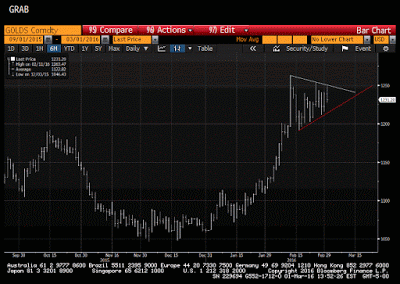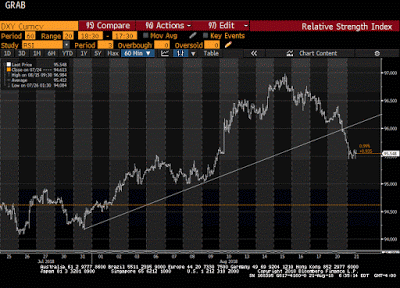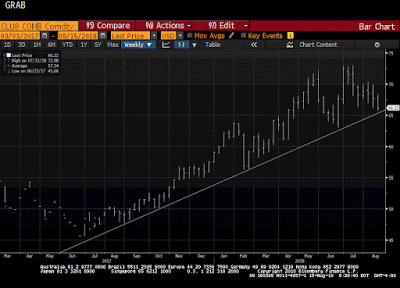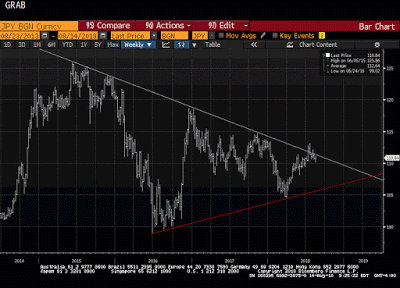During a period in which the zero bound no longer is the floor of interest rates, and many central banks continue to ease policy, we have been watching gold a bit closer.
In early January, we noted that the technical pattern warned of breakout. Our first objective was $1110-$1135.
In early February, we updated our view with gold trading near $1150. The charts still looked constructive; we suggested a new target near $1200.
The increasingly precious metal rose to almost $1263.5o on February 11. Since then, it has been carving out a symmetrical triangle pattern, as depicted in the Great Graphic here (that was composed on Bloomberg). The symmetrical triangle is most often a continuation pattern. Occasionally, it is a reversal pattern.
The upper end of the triangle was tested earlier today with the two attempts on $1249. This reinforces the resistance at the top of the triangle. The bottom is near $1215 today, and it rises by about $2.5 a day.
The technical indicators are not particularly helpful at the moment. The RSI is neutral, and the MACDs have turned lower but are moving broadly sideways. The slow stochastics appear to be bottoming. As a point of reference, the 20-day moving average is a little below $1210.
If this triangle is a continuation pattern, the objective is in the $1300-$1320 area. It is not uncommon for there to be initial false breaks from the triangle pattern. On such a move, the $1191 area is interesting. It is the low point since the high was reached on February 11.
If this triangle is a rare reversal pattern, a break of $1180 may be necessary to confirm it. The initial target is $1155 and then $1130.
Although the idea of gold as a safe haven would suggest that it would trade inversely to a risk asset such as the S&P 500. However, using a 60-day rolling correlation between the percentage change of gold and the S&P 50, the correlation was positive for most of the 2011-2013. Gold was treated like another risk asset. From February 2014 through April 2015, the correlation switched from positive to negative (inverse). The correlation went back and forth from April through August and then it turned decisively negative through November.
The correlation turned positive in late November through early January 2016. It then flipped to inversion again and today it is the most inverse since Q4 2011. This suggests, but, of course, does not guarantee that for the triangle pattern in gold to be a continuation pattern, equity markets would likely have to renew their decline. Alternatively, if the triangle pattern is a reversal pattern, then stocks would likely continue to their recovery. Many major markets have moved higher for the past two weeks.
Another implication is about the Japanese yen. It has been moving in the opposite direction of the S&P 500. The 60-day correlation between percentage change of the S&P 500 and the yen (against the dollar) is about -0.59. Since 2009, the inversion has rarely exceeded -0.60, and on the four episodes that are have surpassed it, it has not gone beyond -0.80.
The yen and gold are positively correlated. In fact since around July 2013, the correlation has not been negative. There have been only two brief periods in which the correlation dipped below 0.20. Today, the correlation is edging above 0.50 for the first since last April.
This is not to say the yen is as good as gold. Today the MOF auctioned 10-year bonds for the first time with a negative yield. The negative yields in Europe and Japan have reduced the "carrying costs" of gold. At the same time, concern about the health of banks in a negative interest rate environment, and when there is much concern about officials making it harder to hoard cash (ECB considering taking the 500 euro note out of circulation), there some see gold as a haven.
Tags: Great Graphic







































